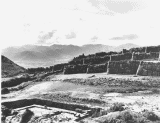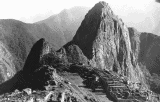The Andes
Life in the Highlands
Organized states and advanced cultures had long flourished in the Andean mountain region. The semi-arid highlands were the center of the far-flung Inca empire, Tahuantinsuyu, that extended from today's Chile to Colombia. Cuzco, the capital, was located at 10,000 feet above sea level.
Impressive adaptations to this unique environment allowed civilizations to thrive at higher altitudes than anywhere else in the world. The Andean peoples had learned to freeze-dry foods by taking advantage of the daily extremes of temperature at high altitudes. They kepts herds of llamas and alpacas in the altiplano, weaving textiles from the wool. Using irrigation and terracing, they developed varieties from the wool. Using irrigation and terracing, they developed varieties of potatoes at high altitudes; grew corn and coca at lower levels; and raised cotton in the lowlands. They were knowledgeable miners, fine metalworkers, and great builders.
A rotating system of labor for public works that was traditional among Andean peoples was used to construct thousands of miles of roads. These roads greatly facilitated the movement of troops, peoples, and goods.
- Sacsahuaman, Peru

The huge fortifications surrounding the Incan capital of Cuzco, built to protect and to solidify Incan control, are outstanding examples of the advanced engineering technicques of Andean peoples. Stones of several tons in weight were precisely cut and placed in jigsaw-like fashion, without the aid of mortar, to form massive walls. These stone structures have withstood numerous earthquakes during the intervening centuries.
- Ruins at Machu Picchu, Peru

This magnificent center of Incan culture, high in the Andes, is testimony to the extraordinary contruction capability of Andean peoples (i.e., intricate stone construction without the aid of mortar) before the arrival of the Spanish in the early 16th century.

 Continue the Voyage with
South Atlantic Peoples or abandon ship and use the
Outline.
Continue the Voyage with
South Atlantic Peoples or abandon ship and use the
Outline.



 Continue the Voyage with
Continue the Voyage with